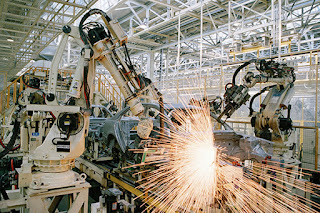Internet of Things (IoT) is an ecosystem of connected physical object that are accessible through the internet. The 'thing' in IoT could be a person with a heart monitor or an automobile with built-in-sensors, i.e. objects that have been assigned an IP address and have the ability to collect and transfer data over a network without manual assistance or intervention. The embedded technology in the objects helps them to interact with internal states or the external environment, which in turn affects the decisions taken.
Internet of Things (IoT) is the inter-networking of physical devices, vehicles, buildings and other items embedded with electronics, software, sensors, actuators and network connectivity which enable these objects to collect and exchange data.
The IoT allows objects to be sensed or controlled remotely across existing network infrastructure, creating opportunities for more direct integration of the physical world into computer based systems and resulting in improved efficiency, accuracy and economic benefit in addition to reduced human intervention.
The vast network of devices connected to the internet, including smart phones and tablets and almost anything with a sensor on it - cars, machines in production plants, jet engines, oil drills, wearable devices and more. These 'things' collect and exchange data.
IoT - and the machine-to-machine (M2M) technology behind it - are bringing a kind of "super visibility" to nearly every industry. Imagine utilities and telcos that can predict and prevent service outages, airlines that can remotely monitor and optimise plane performance, and healthcare organisations that can base treatment on real-time genome analysis. The business possibilities are endless.
There are other terminologies -
Industrial Internet of things (IIoT) : Machine learning, M2M communication, sensor data, and automation technologies work together to create autonomous smart machines and connected factories.Internet of Everything (IoE) : The Internet of Everything adds intelligent connections between things and devices, people, processes, and data. IoE systems make sensor data more meaningful and have a secure, usable infrastructure that lets actionable information be shared across the business ecosystem.
While building an IoT strategy 6 terminologies are required -
IoT security - As companies collect data beyond traditional IT boundaries, IoT security measures will be critical. Some key considerations include being able to secure and monitor devices, encrypt sensitive data, and build risk mitigation into systems.
Streaming Data - IoT applications accumulate more data than traditional batch processing can manage. Having capabilities for streaming data continually is key to reliably feeding real-time business processes and extracting timely insights.
IoT Platform - An IoT platform makes it possible to develop, deploy and manage IoT and M2M applications. Automate processes and network connections, store and manage sensor data, connect and control your devices and analyse your data.
IoT Application - “Next generation” IoT applications must be able to capture, collect, interpret, and act on vast amounts of information – detecting connectivity gaps, handling interruptions, and meeting specific business and industry requirements.
IoT Cloud - IoT cloud solutions provide affordable access to high-speed data networks – to significantly extend the reach and usability of your IoT applications. They can also offer data storage, processing, analysis, and remote device management.
IoT Data - IoT data management technologies ensure that you can collect the right data at the right time, even when connectivity is interrupted. Rely on in-memory systems to process massive data volumes generated by thousands of devices.
IoT is a transformational force that can help companies improve performance through IoT analytics and IoT Security to deliver better results.













No comments:
Post a Comment